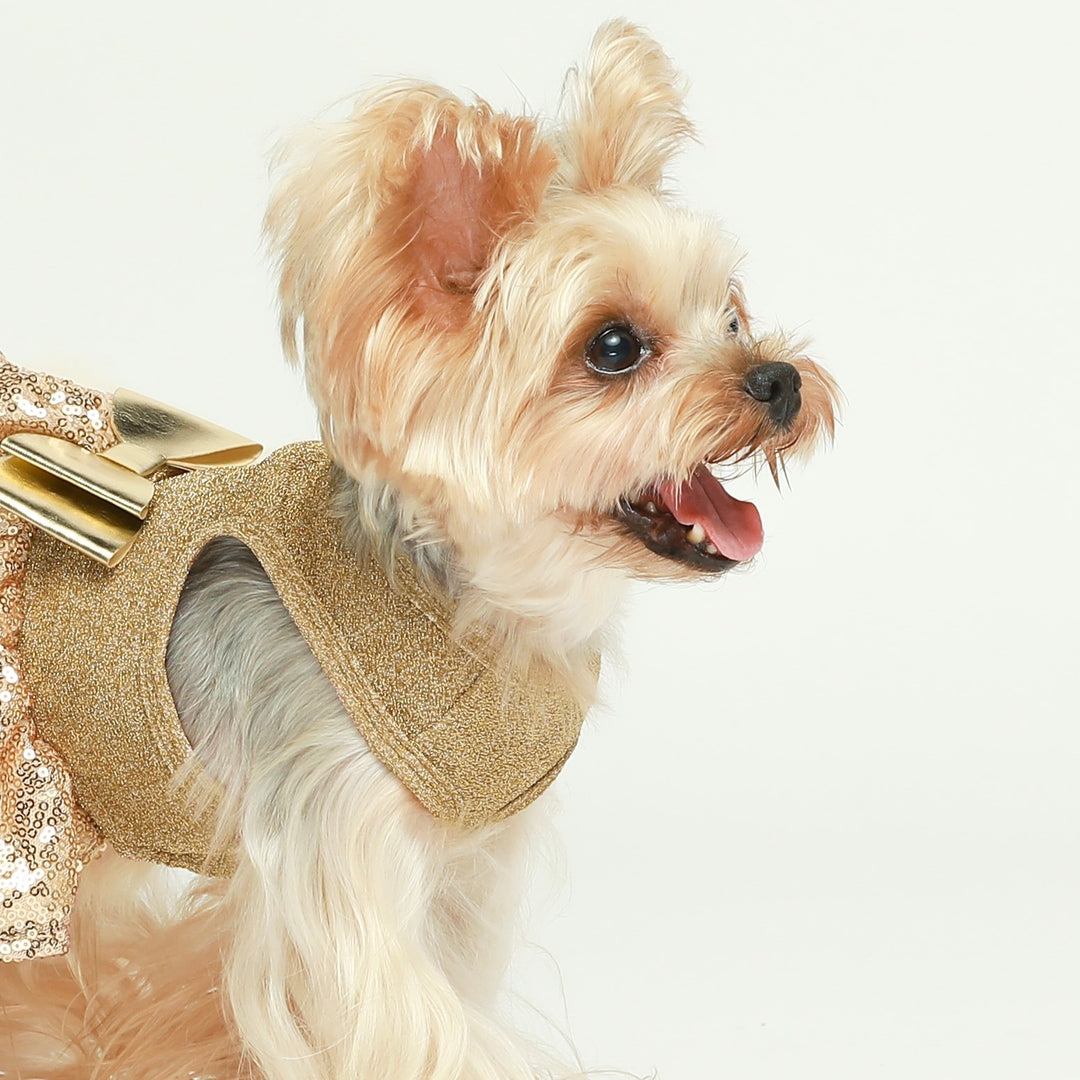Summer Pet Nutrition Tips: Hydrate, Feed, and Care
When summer rolls around with its heat and long days, it’s time to think about what our pets are eating. They need to switch things up when it gets hot outside. They would require a change in diet while the temperatures soar. The animals would drink more water, and some foods could actually be detrimental to one’s health while the temperatures are warm. This article will help you sort out your summer diet for your pet. We’ll go over the must-haves and definite no-nos, along with some tips for how to help your four-legged friends feel great when things get hot.

Instagram: baileythequarendoggo
Maltipoo in a Hawaiian Ruffle Dog Dress
1. Keeping Your Pet Hydrated and Happy
The Importance of Water
With the mercury rising, keeping your pet hydrated is more imperative than ever. Obviously, pets can get dehydrated fast in the heat, though they may not always remember to drink enough. Check their water bowl and make sure that it is full and refreshed all the time. You can even place a few ice cubes in it to cool it down or set up a second station if you have a big house or yard.
Wet Foods for Extra Hydration
You probably didn’t know that wet food can give your pet extra hydration. While it doesn’t replace drinking water, it contributes some extra moisture when added to their diet. This is practically helpful on the part of those pets that don’t seem to drink enough water during the day. Mix a little with their regular dry food or as an occasional treat during hot days.

Instagram: prettypennyandindy
French Bulldog in a Rainbow Striped Dog Dress
DIY Hydrating Treats
You can also make hydration fun by preparing homemade treats which help in keeping your pet cool and hydrated. Low-sodium chicken broth makes for a savory snack if frozen in ice cube trays, or blend watermelon with seeds removed and then freeze the puree in molds for some sweet and hydrating treat. Keep in mind that these are on top of everything, not to substitute a pet’s normal diet and hydration.
2. Adjusting Your Pet’s Diet for the Heat
Lighter Meals, More Often
Just like humans might prefer lighter or smaller meals when it’s hot, pets can benefit from this approach too. Eating a big meal can increase their body temperature as they digest it, which isn’t what you want during a heatwave. Consider feeding them smaller amounts but more frequently throughout the day to keep their energy levels up without overheating.
Seasonal Fruits and Veggies
Some fruits and vegetables can be a great addition to your pet’s summer diet, offering hydration and essential nutrients. However, it’s crucial to know which ones are safe for your pet. Apples (without the seeds), blueberries, cucumbers, and carrots can be refreshing treats. Always introduce new foods slowly and in small quantities to avoid upsetting their stomach.

Instagram: buenoandfelix
Jack Russell in a Color Block Dog Shirt
Watch Out for Signs of Overheating
Even with a perfect diet, pets can still suffer from the heat. Know the signs of overheating and heatstroke: excessive panting, drooling, lethargy, or even vomiting. If your pet is showing any of these signs, it’s crucial to cool them down gradually and contact your vet for advice.
Taking these steps to adjust your pet’s diet and hydration habits during the summer can make a big difference in how they feel. It’s all about keeping them comfortable, energized, and ready to enjoy the sunny days with you.
For further reading, check out Fun and Safe Summer Exercise for Dogs.
3. Foods to Keep Off Your Pet’s Summer Menu
Human Snacks That Should Stay on the Human Plate
It’s tempting to share our summer treats with our furry friends, especially when they give us those big, pleading eyes. But certain human foods can be harmful to pets. Chocolate, avocado, grapes, and onions are a definite no-go year-round, including summer. And while it might seem like a good idea to share your ice cream to cool them down, dairy can cause stomach upsets in many pets. Stick to pet-safe treats instead. Read More:What common household items are toxic to dogs?

Instagram: lil.yorkie.laci
Yorkie in a Ruffle Sleeves Sunflower Dog Dress
Beware of Seasonal Toxins Outdoors
Summer isn’t just about fun in the sun; it also brings hazards like pesticides, fertilizers, and poisonous plants, all of which can end up in your pet’s mouth during an outdoor adventure. Keep an eye on what they’re sniffing or nibbling on during walks or in the garden. If you’re using any chemicals on your lawn or plants, make sure they are pet-friendly and always follow the safety instructions.
The Ice Cream Temptation
Yes, we’ve all been there. It’s a hot day, and your pet looks like they could use a cool treat. While sharing your ice cream cone might seem harmless, it’s better to avoid giving pets dairy products. Instead, prepare some pet-specific frozen treats that won’t upset their stomach. Frozen berries, for instance, can be a much healthier choice that still provides that satisfying cold crunch.
4. Mealtime Adjustments for Hotter Days
Timing is Everything
During summer, the heat can make your pet feel sluggish, especially right after meals. To help them cope, try adjusting their feeding times to cooler parts of the day—early morning or later in the evening. This way, they won’t have to digest their food during the hottest part of the day, making it easier for them to stay comfortable and energized.

Instagram: deo_piper_cavoodles
Cavoodle in a Floral Dog Dress
Portion Control in the Heat
Pets may become less active in the extreme heat, which means they might not need as many calories. Pay attention to their activity level and adjust their portions accordingly to prevent weight gain. However, don’t cut back too suddenly or drastically. It’s all about finding a balance that keeps them at a healthy weight without leaving them hungry.
Keeping an Eye on Their Condition
Regularly check your pet’s weight and overall condition throughout the summer. A good rule of thumb is being able to feel but not see their ribs. If you’re unsure about their diet or notice any sudden changes in their weight or appetite, it’s a good idea to consult with your vet. They can provide advice tailored to your pet’s specific health needs and lifestyle.
Adjusting your pet’s diet and meal schedule according to the summer heat can significantly contribute to their overall well-being. With these guidelines, you’re equipped to ensure your pet not only stays cool but also enjoys the season to its fullest – all while staying healthy and satisfied.

Instagram: belletheepoodlehead
Poodle in a Tie Dye Denim Dog Dress
5. Sizing Up Supplements: When to Boost Your Pet’s Summer Diet
Tailoring Supplements for the Sunny Season
Summertime can be taxing on your pets, and sometimes their regular diet might not cover all their nutritional needs. Supplements like omega fatty acids can keep their skin less itchy and their coats shiny, especially when they’re shedding their winter layers. Glucosamine is also great for keeping joints healthy, particularly if increased activity is on your pet’s summer agenda.
Vitamin Vigilance for Vibrant Pets
Just as we might need an extra vitamin D boost when we’re spending more time indoors, pets can benefit from vitamins during the summer too. Vitamins E and A can protect their skin and fur, while B vitamins can boost energy levels. But remember, before you start supplementing, chat with your vet to get the right mix and dosage for your pet’s breed, size, and age.

Vet-Approved Supplements Only
The market is full of supplements claiming miraculous benefits, but not all are created equal or necessary. To avoid doing more harm than good, stick to vet-recommended brands and products. Your vet knows what’s best for your pet’s unique health profile and dietary needs, ensuring you choose supplements that will truly benefit them without any unwanted side effects.
6. Catering to Special Dietary Needs Across the Board
Youngsters vs. Old Timers
Puppies and kittens have different dietary requirements compared to senior pets, and summer doesn’t change that. Younger animals may need more calories and nutrients to support their growth, while older pets might require a diet that’s easy on the kidneys and rich in fiber. Adjust their meals accordingly, and always keep fresh water available to help with hydration.
Breed-Specific Nutritional Know-How
Some breeds are prone to certain conditions that can be exacerbated by the heat. For example, brachycephalic breeds like Bulldogs and Pugs might struggle with breathing in the heat, so avoid foods that cause bloating or gas. On the other hand, thick-coated breeds might need extra help shedding their undercoat; omega-rich foods can aid in this process.

Instagram: wakanda_shihtzu
Shih Tzu in a Flamingo Dog Dress
Managing Chronic Conditions with Diet
If your pet has diabetes, heart disease, or any chronic condition, dietary management becomes even more critical in the summer. Meals rich in specific nutrients and low in fats or sugars might be needed. Your veterinarian can guide you through the maze of dietary dos and don’ts, ensuring your pet’s condition doesn’t worsen with the changing seasons.
7. Crafting Cool Treats for Your Pet
Homemade Frozen Delights
Who doesn’t love a popsicle on a hot day? Your pets will love them, too! Whip up some easy homemade frozen treats to help them beat the heat. You can freeze low-sodium chicken broth or make a puree of pet-safe fruits and veggies, then freeze it in ice cube trays or special pet treat molds. These icy snacks will help cool down your pet, and they’re a fun way to add a little extra nutrition to their diet.
The Raw Debate: To Cook or Not to Cook?
During summer, you might be wondering whether it’s better to serve your pet’s vegetables raw or cooked. While cooking can make some nutrients more digestible, raw foods often retain more vitamins and can be crunchier and more enjoyable for your pet to eat. The key is balance and knowing what your individual pet can handle. If you’re introducing raw foods, do it gradually and watch how your pet reacts.

Instagram: tinygirllisa
Pomeranian in a Plaid Summer Dog Dress
Engaging Feeding Toys for Fun and Health
Mealtime isn’t just about eating; it can also be an opportunity for play and mental stimulation. Use feeding toys that encourage your pet to work for their food, which can slow down fast eaters and make mealtime feel like a game. This is especially useful in the summer when you want to encourage indoor activity in the cool air-conditioned environment or in the shade outdoors. For more ideas on keeping your pet active and entertained during hot weather, check out these fun and safe summer workouts for dogs.
Final Thoughts
Staying cool is key, so remember those fresh water bowls and homemade icy treats. Adjust meal sizes if needed, watch for signs of overheating, and steer clear of human snacks that aren’t safe for pets. If your pet starts acting differently or isn’t eating well, it might be time for a vet visit. Now you’re all set! Here’s to a fantastic summer of playtime, relaxation, and bonding with your pet. Keep it simple, keep it safe, and have a blast under the sun!














